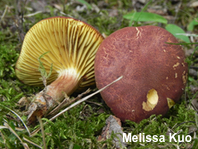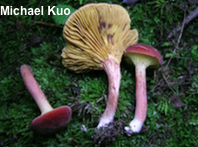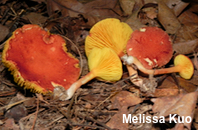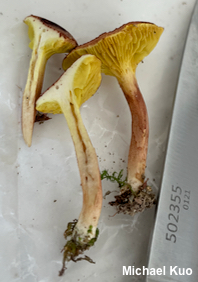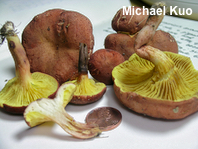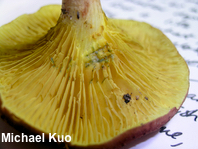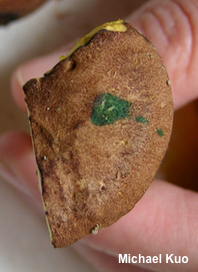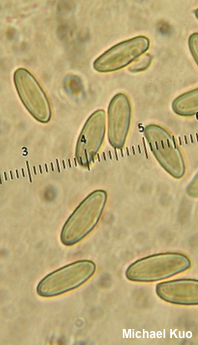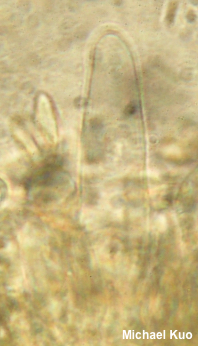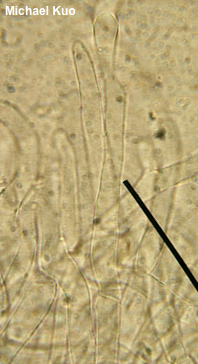| Major Groups > Gilled Mushrooms > Phylloporus & Phylloporus > Phylloporus leucomycelinus |

|
Phylloporus leucomycelinus [ Basidiomycota > Boletales > Boletaceae > Phylloporus . . . ] by Michael Kuo, 22 October 2025 Phylloporus leucomycelinus can be separated from similar American and Canadian gilled boletes on the basis of its association with oaks and the white mycelium at the base of the stem. In fact the white basal mycelium is virtually the only thing separating Phylloporus leucomycelinus from Phylloporus rhodoxanthus, which is found in the same ecosystems and is virtually identical but features yellow basal mycelium. If that all sounds easy enough, allow me to crash your easy identification party with a complication. Both leucomycelinus and rhodoxanthus are frequently attacked by a white Hypomyces that begins its parasitic journey at the base of the stem. While the Hypomyces (it is probably Hypomyces microspermus) is sometimes clearly a Hypomyces, it can also appear exactly like basal mycelium, especially when it is just beginning to develop. Illustrations can be found on the page for gilled boletes. Sometimes the Hypomyces can be scraped off carefully to reveal white mycelium beneath, especially in the case of dried specimens. But a more reliable cross-check involves examining a bit of the putative mycelium under the microscope; if it is actually a Hypomyces, corresponding hyphal structures and aleuriospores will be present. Some sources emphasize blue-staining gills and flesh for Phylloporus leucomycelinus, but the staining is more variable than the literature supposes—in fact, a majority of my leucomycelinus collections over the years have not stained blue. Description: Ecology: Mycorrhizal with oaks and possibly other hardwoods; growing alone or gregariously; summer; originally described from Michigan (Singer 1978); probably widely distributed in North America east of the Rocky Mountains. The illustrated and described collections are from Illinois and Ohio. Cap: 2–6 cm; broadly convex, becoming planoconvex; dry; finely velvety or nearly bald; sometimes developing a fine network of cracks; reddish brown to brown. Gills: Running down the stem or beginning to do so; close or nearly distant; short-gills frequent; bright yellow, becoming dirty olive yellow to tan with age; sometimes developing brownish spots and discolorations with age; staining blue when damaged, or often not staining. Stem: 20–50 mm long; 2–10 mm thick; equal, or with a flared apex and a tapered base; often with extending "gill lines" at the apex; dry; bald or a little fibrillose; yellowish above, reddish below; basal mycelium white (but see discussion above). Flesh: Whitish to yellowish, or orangish in the stem base with age; staining blue when exposed, or not staining. Odor and Taste: Not distinctive. Chemical Reactions: Ammonia green on fresh cap surface; brown to reddish brown on dried cap surface. Fleeting amyloid reaction positive for gill tissue. Microscopic Features: Spores 10–14 x 3–4.5 µm; fusiform; hyaline to yellowish in KOH; brownish in Melzer's reagent. Basidia 32–38 x 5–9 µm; clavate; 4-sterigmate. Pleurocystidia 55–80 x 10–15 µm; widely fusiform or subcylindric; smooth; thin- or somewhat thick-walled; hyaline to yellowish in KOH. Pileipellis a trichoderm; elements 6–12 µm wide, cylindric, smooth or roughened; hyaline in KOH; terminal cells cylindric with rounded or occasionally subclavate to clavate apices; subterminal cells cylindric. Stipitipellis a layer of repent, parallel, cylindric hyphae 4–10 µm wide, hyaline in KOH; caulohymenium arising in tufts, golden in KOH. Clamp connections not found. REFERENCES: R. Singer, 1978. (McNeil, 2006; Neves & Halling, 2010; Farid et al., 2018; Sturgeon, 2018; Gutiérrez-Domínguez et al., 2024.) Herb. Kuo 07190805, 06161402, 07061401, 08241403, 06231502, 06252504. This site contains no information about the edibility or toxicity of mushrooms. |
© MushroomExpert.Com |
|
Cite this page as: Kuo, M. (2025, October). Phylloporus leucomycelinus. Retrieved from the MushroomExpert.Com Web site: http://www.mushroomexpert.com/phylloporus_leucomycelinus.html |
